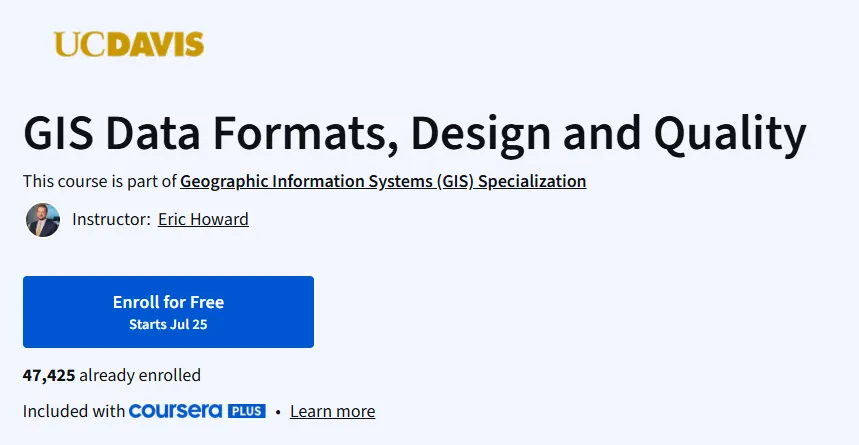What will you learn in GIS Data Formats, Design and Quality Course
Understand different types of GIS data and sources.
Acquire, process, and manage spatial data.
Design high-quality maps using cartographic principles.
Apply ethical considerations in GIS data usage.
Program Overview
Module 1: Understanding GIS Data Types
⏱️ 1 week
Topics: Raster vs. vector data, spatial vs. attribute data.
Hands-on: Compare various GIS datasets and formats.
Module 2: GIS Data Acquisition
⏱️ 1 week
Topics: GPS, remote sensing, data scraping, public data repositories.
Hands-on: Collect and import spatial datasets from multiple sources.
Module 3: Data Quality and Ethics
⏱️ 1 week
Topics: Accuracy, completeness, metadata, and data bias.
Hands-on: Assess and document GIS data quality.
Module 4: Map Design Principles
⏱️ 1 week
Topics: Color, symbology, layout, typography, map types.
Hands-on: Create visually effective maps using ArcGIS or QGIS.
Module 5: Communicating with Maps
⏱️ 1 week
Topics: Audience-focused design, storytelling with maps.
Hands-on: Publish or share a professional-quality map project.
Get certificate
Job Outlook
GIS and spatial data analysis are rapidly growing across urban planning, logistics, environmental monitoring, and disaster management.
Skills in spatial data collection and map visualization are in high demand.
Entry-level GIS technician roles offer salaries between $50,000–$70,000/year, with senior analysts earning over $90,000.
Strong freelance and remote work opportunities in mapping, consulting, and geospatial storytelling.
Specification: GIS Data Formats, Design and Quality
|
FAQs
- Prior experience is helpful but not required.
- The course introduces software usage step by step.
- Focuses on conceptual understanding of spatial data.
- Software exercises reinforce learning but aren’t mandatory.
- Suitable for beginners aiming to learn GIS fundamentals.
- Useful in environmental monitoring, logistics, and disaster management.
- Valuable for data analysis, consulting, and mapping projects.
- Helps develop storytelling skills using spatial data.
- Supports freelance and remote GIS work opportunities.
- Enhances employability in multiple geospatial industries.
- Covers accuracy, completeness, and metadata documentation.
- Introduces ethical considerations in data acquisition and usage.
- Teaches learners to identify biases in spatial datasets.
- Helps ensure maps are reliable and responsibly communicated.
- Encourages transparency and accountability in GIS work.
- Focuses on visual design principles: color, symbology, layout, and typography.
- Emphasizes audience-focused map communication.
- Provides practical exercises for publishing and sharing maps.
- Prepares learners to present spatial data effectively.
- Bridges technical GIS skills with storytelling.
- Designed to be accessible to a wide audience.
- Provides conceptual knowledge without heavy programming.
- Helps managers understand spatial data for decision-making.
- Enhances communication between technical and non-technical teams.
- Supports strategic planning and data-driven storytelling.





